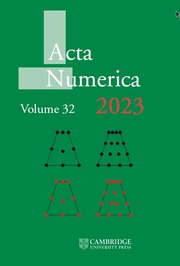Crossref Citations
This article has been cited by the following publications. This list is generated based on data provided by
Crossref.
Sinescu, Vasile
Kuo, Frances Y.
and
Sloan, Ian H.
2013.
Monte Carlo and Quasi-Monte Carlo Methods 2012.
Vol. 65,
Issue. ,
p.
631.
Mishra, Siddhartha
Schwab, Christoph
and
Šukys, Jonas
2013.
Uncertainty Quantification in Computational Fluid Dynamics.
Vol. 92,
Issue. ,
p.
225.
Dick, Josef
and
Gnewuch, Michael
2014.
Optimal randomized changing dimension algorithms for infinite-dimensional integration on function spaces with ANOVA-type decomposition.
Journal of Approximation Theory,
Vol. 184,
Issue. ,
p.
111.
Kämmerer, Lutz
Kunis, Stefan
Melzer, Ines
Potts, Daniel
and
Volkmer, Toni
2014.
Extraction of Quantifiable Information from Complex Systems.
Vol. 102,
Issue. ,
p.
347.
Crăciun, Cora
2014.
Homogeneity and EPR metrics for assessment of regular grids used in CW EPR powder simulations.
Journal of Magnetic Resonance,
Vol. 245,
Issue. ,
p.
63.
Hinrichs, Aicke
Novak, Erich
and
Ullrich, Mario
2014.
On weak tractability of the Clenshaw–Curtis Smolyak algorithm.
Journal of Approximation Theory,
Vol. 183,
Issue. ,
p.
31.
Goda, Takashi
2014.
Construction of scrambled polynomial lattice rules over $\mathbb{F}_{2}$ with small mean square weighted $\mathcal{L}_{2}$ discrepancy.
BIT Numerical Mathematics,
Vol. 54,
Issue. 2,
p.
401.
Aistleitner, Christoph
2014.
Tractability results for the weighted star-discrepancy.
Journal of Complexity,
Vol. 30,
Issue. 4,
p.
381.
Zhu, Houying
and
Dick, Josef
2014.
Discrepancy bounds for deterministic acceptance-rejection samplers.
Electronic Journal of Statistics,
Vol. 8,
Issue. 1,
Dick, Josef
2014.
Numerical integration of Hölder continuous, absolutely convergent Fourier, Fourier cosine, and Walsh series.
Journal of Approximation Theory,
Vol. 183,
Issue. ,
p.
14.
Leobacher, Gunther
and
Pillichshammer, Friedrich
2014.
Introduction to Quasi-Monte Carlo Integration and Applications.
p.
55.
Helton, Jon C.
Pilch, Martin
and
Sallaberry, Cédric J.
2014.
Probability of loss of assured safety in systems with multiple time-dependent failure modes: Representations with aleatory and epistemic uncertainty.
Reliability Engineering & System Safety,
Vol. 124,
Issue. ,
p.
171.
Nichols, James A.
and
Kuo, Frances Y.
2014.
Fast CBC construction of randomly shifted lattice rules achievingO(n−1+δ)convergence for unbounded integrands overRsin weighted spaces with POD weights.
Journal of Complexity,
Vol. 30,
Issue. 4,
p.
444.
Kuo, Frances Y.
Schwab, Christoph
and
Sloan, Ian H.
2015.
Multi-level Quasi-Monte Carlo Finite Element Methods for a Class of Elliptic PDEs with Random Coefficients.
Foundations of Computational Mathematics,
Vol. 15,
Issue. 2,
p.
411.
Faure, Henri
Kritzer, Peter
and
Pillichshammer, Friedrich
2015.
From van der Corput to modern constructions of sequences for quasi-Monte Carlo rules.
Indagationes Mathematicae,
Vol. 26,
Issue. 5,
p.
760.
Brauchart, J.S.
Dick, J.
Saff, E.B.
Sloan, I.H.
Wang, Y.G.
and
Womersley, R.S.
2015.
Covering of spheres by spherical caps and worst-case error for equal weight cubature in Sobolev spaces.
Journal of Mathematical Analysis and Applications,
Vol. 431,
Issue. 2,
p.
782.
Dick, Josef
Kuo, Frances Y.
Le Gia, Quoc T.
and
Schwab, Christoph
2015.
Fast QMC Matrix-Vector Multiplication.
SIAM Journal on Scientific Computing,
Vol. 37,
Issue. 3,
p.
A1436.
Gerber, Mathieu
and
Chopin, Nicolas
2015.
Sequential Quasi Monte Carlo.
Journal of the Royal Statistical Society Series B: Statistical Methodology,
Vol. 77,
Issue. 3,
p.
509.
Dick, Josef
Hinrichs, Aicke
and
Pillichshammer, Friedrich
2015.
Proof techniques in quasi-Monte Carlo theory.
Journal of Complexity,
Vol. 31,
Issue. 3,
p.
327.
Dick, Josef
Kritzer, Peter
Leobacher, Gunther
and
Pillichshammer, Friedrich
2015.
A reduced fast component-by-component construction of lattice points for integration in weighted spaces with fast decreasing weights.
Journal of Computational and Applied Mathematics,
Vol. 276,
Issue. ,
p.
1.


